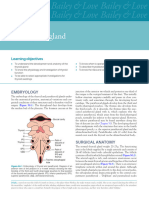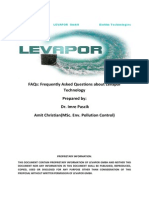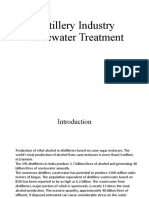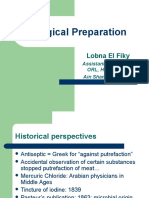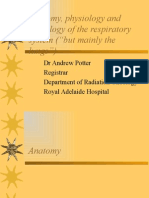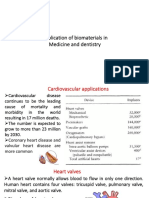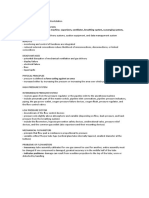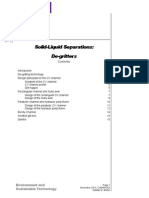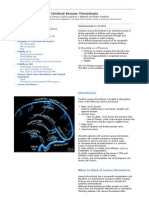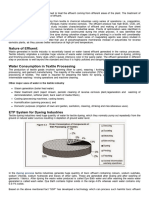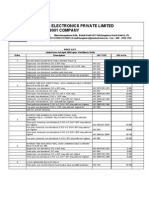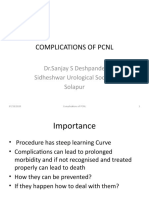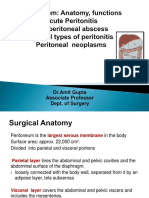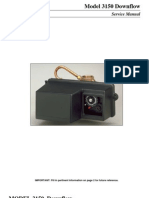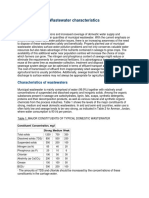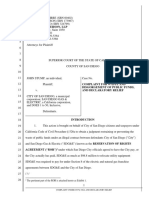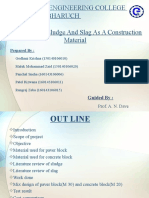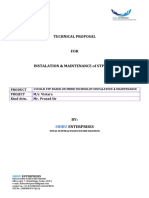Water Supply Notes
Water Supply Notes
Uploaded by
Venkat RamanCopyright:
Available Formats
Water Supply Notes
Water Supply Notes
Uploaded by
Venkat RamanCopyright
Available Formats
Share this document
Did you find this document useful?
Is this content inappropriate?
Copyright:
Available Formats
Water Supply Notes
Water Supply Notes
Uploaded by
Venkat RamanCopyright:
Available Formats
Water Supply Engineering
TCE BEPT Notes
SYSTEM OF WATER SUPPLY ENGINEERING
Water Supply Engineering
TCE BEPT Notes
SOURCES OF WATER SUPPLY SURFACE SOURCES All the sources of water can be broadly divided into 1. Surfaces sources and 2. Sub surface sources The surface sources further divided into i. Streams Ii. Rivers iii. Ponds Iv. Lakes v. Impounding reservoirs etc. NATURAL PONDS AND LAKES In mountains at some places natural basins are formed with impervious bed by springs and streams are known as lakes. The quality of water in the natural ponds and lakes depends upon the basins capacity, catchment area, annual rainfall, porosity of ground etc. But lakes and ponds situated at higher altitudes contain almost pure water which can be used without any treatment. But ponds formed due to construction of houses, road, and railways contains large amount of impurities and therefore cannot be used for water supply purposes. STREAMS AND RIVERS Rivers and streams are the main source of surface source of water. In summer the quality of river water is better than mansoon. Because in rainy season the run-off water also carries with clay, sand, silt etc. which make the water turbid. So river and stream water require special treatments. Some rivers are snow fed and perennial and have water throughout the year and therefore they do not require any arrangements to hold the water. But some rivers dry up wholly or partially in summer. So they require special arrangements to meet the water demand during hot weather. Mostly all the cities are Situated near the rivers discharge their used water of sewage in the rivers, therefore much care should be taken while drawing water from the river. IMPOUNDING RESERVOIRS In some rivers the flow becomes very small and cannot meet the requirements of hot weather. In such cases, the water can be stored by constructing a bund, a weir or a dam across the river at such places where minimum area of land is submerged in the water and max. Quantity of water to be stored. In lakes and reservoirs, suspended impurities settle down in the bottom, but in their beds algae, weeds, vegetable and organic growth takes place which produce bad smell, taste and color in water. Therefore this water should be used after purification. When water is stored for long time in Reservoirs it should be aerated and chlorinated to kill the microscopic organisms which are born in water.
SUBSURFACE SOURCES
Water Supply Engineering
TCE BEPT Notes
These are further divided into (i) Infiltration galleries (ii) Infiltration wells (iii) Springs etc. (iv) wells INFILTRATION GALLERIES A horizontal nearly horizontal tunnel which is constructed through water bearing strata for tapping underground water near rivers, lakes or streams are called Infiltration galleries. The yield from the galleries may be as much as 1.5 x 104 lit/day/meter length of infiltration gallery. For maximum yield the galleries may be placed at full depth of the aquifer. Infiltration galleries may be constructed with masonry or concrete with weep holes of 5cm x 10cm.
Fig: Infiltration Gallery INFILTRATION WELLS In order to obtain large quantity of water, the infiltration wells are sunk in series in the blanks of river. The wells are closed at top and open at bottom. They are constructed by brick masonry with open joints as shown in fig. For the purpose of inspection of well, the manholes are provided in the top cover. The water filtrates through the bottom of such wells and as it has to pass through sand bed, it gets purified to some extent. The infiltration well in turn is connected by porous pipes to collecting sump called jack well and there water is pumped to purification plant for treatment.
Fig: Infiltration Well
Fig: Jack Well
SPRINGS Sometimes ground water reappears at the ground surface in the form of springs. Springs generally supply small springs. Springs generally supply small quantity of water and hence suitable for the hill towns. Some springs discharge hot water due to presence of sulphur and useful only for the curve of certain skin disease patients.
Water Supply Engineering
TCE BEPT Notes
TYPES OF SPRINGS 1) Gravity Springs: When the surface of the earth drops sharply the water bearing stratum is exposed to atmosphere and gravity springs are formed as shown in fig.
Fig:Gravity Spring
2) Surface Spring: This is formed when an impervious stratum which is supporting
the ground water reservoir becomes out crops as shown in fig.
Fig:Surface Spring
3) Artesian Spring: When the ground water rises through a fissure in the upper
impervious stratum as shown in fig. When the water-bearing stratum has too much hydraulic gradient and is closed between two imperious stratum, the formation of Artesian spring from deep seated spring
Fig: Artesian Spring WELLS
Water Supply Engineering
TCE BEPT Notes
A well is defined as an artificial hole or pit made in the ground for the purpose of tapping water. In India 75 to 85% of Indian population has to depend on wells for its water supply. The three factors which form the basis of theory of wells are 1. Geological conditions of the earths surface 2. Porosity of various layers 3. Quantity of water, which is absorbed and stored in different layers. The following are different types of wells 1. Shallow wells 2. Deep wells 3. Tube wells 4. Artesian wells Shallow Wells Shallow wells are constructed in the uppermost layer of the earths surface. The diameter of well varies from 2 to 6 m and a maximum depth of 7m. Shallow wells may be lined or unlined from inside. Fig shows a shallow well with lining. These wells are also called draw wells or gravity wells or open wells or drag wells or percolation wells. Quantity of water available from shallow wells is limited as their source of supply is uppermost layer of earth only and sometimes may even dry up in summer. Hence they are not suitable for public water supply schemes. The quantity of water obtained from shallow wells is better than the river water but requires purification. The shallow wells should be constructed away from septic tanks, soak pits etc because of the contamination of effluent. The shallow wells are used as the source of water supply for small villages, undeveloped municipal towns, isolated buildings etc because of limited supply and bad quality of water. Fig: Shallow Well Deep Wells The Deep wells obtain their quota of water from an aquifer below the impervious layer as shown in fig No. The theory of deep well is based on the travel of water from the outcrop to the site of deep well. The outcrop is the place where aquifer is exposed to the atmosphere. The rain water entered at outcrop and gets thoroughly purified when it reaches to the site of deep well. But it dissolves certain salts and therefore become hard. In such cases, some treatment would be necessary to remove the hardness of water.
Fig : Deep Well The depth of deep well should be decided in such a way that the location of out crop is not very near to the site of well. The water available at a pressure greater atmospheric pressure, therefore deep wells are also referred to as a pressure wells.
Water Supply Engineering
TCE BEPT Notes
UNIT - 2
INTAKES FOR COLLECTING SURFACE WATER The main function of the intakes works is to collect water from the surface source and then discharge water so collected, by means of pumps or directly to the treatment water. Intakes are structures which essentially consists of opening, grating or strainer through which the raw water from river, canal or reservoir enters and carried to the sump well by means of conducts water from the sump well is pumped through the rising mains to the treatment plant. The following points should be kept in mind while selecting a site for intake works. 1. Where the best quality of water available so that water is purified economically in less time. 2. At site there should not be heavy current of water, which may damage the intake structure. 3. The intake can draw sufficient quantity of water even in the worest condition, when the discharge of the source is minimum. 4. The site of the work should be easily approchable without any obstruction 5. The site should not be located in navigation channels 6. As per as possible the intake should be near the treatment plant so that conveyance cost is reduced from source to the water works 7. As per as possible the intake should not be located in the vicinity of the point of sewage disposal for avoiding the pollution of water. 8. At the site sufficient quantity should be available for the future expansion of the water-works. Types of Intake structures: Depending upon the source of water the intake works are classified as following 1. Lake Intake 2. Reservoir Intake 3. River Intake 4. Canal Intake LAKE INTAKE: For obtaining water from lakes mostly submersible intakes are used. These intakes are constructed in the bed of the lake below the water level; so as to draw water in dry season also. These intakes have so many advantages such as no obstruction to the navigation, no danger from the floating bodies and no trouble due to ice. As these intakes draw small quantity of water, these are not used in big water supply schemes or on rivers or reservoirs. The main reason being that they are not easily approachable for maintenance. Fig :Lake Intake
Water Supply Engineering
TCE BEPT Notes
RIVER INTAKE Water from the rivers is always drawn from the upstream side, because it is free from the contamination caused by the disposal of sewage in it. It is circular masonary tower of 4 to 7 m in diameter constructed along the bank of the river at such place from where required quantity of water can be obtained even in the dry period. The water enters in the lower portion of the intake known as sump well from penstocks.
Fig: River Intake RESERVOIR INTAKE: Fig shows the details of reservoir intake. It consists of an intake well, which is placed near the dam and connected to the top of dam by foot bridge. The intake pipes are located at different levels with common vertical pipe. The valves of intake pipes are operated from the top and they are installed in a valve room. Each intake pipe is provided with bell mouth entry with perforations of fine screen on its surface. The outlet pipe is taken out through the body of dam. The outlet pipe should be suitably supported. The location of intake pipes at different levels ensures supply of water from a level lower than the surface level of water. When the valve of an intake pipe is opened the water is drawn off from the reservoir to the outlet pipe through the common vertical pipe. To reach upto the bottom of intake from the floor of valve room, the steps should be provided in Zigzag manner. Fig: Reservoir Intake CANAL INTAKE Fig shows the details of canal intake. A intake chamber is constructed in the canal section. This results in the reduction of water way which increases the velocity of flow. It therefore becomes necessary to provide pitching on the downstream and upstream portion of canal intake. The entry of water in the intake chamber takes through coarse screen and the top of outlet pipe is provided with fine screen. The inlet to outlet pipe is of bell-mouth shape with perforations of the fine screen on its surface. The outlet valve is operated from the top and it controls the entry of water into the
Water Supply Engineering
TCE BEPT Notes
outlet pipe from where it is taken to the treatment plant. Fig: Canal Intake QUALITY OF WATER General Absolutely pure water is never found in nature and contains number of impurities in varying amounts. The rainwater which is originally pure, also absorbs various gases, dust and other impurities while falling. This water when moves on the ground further carries salt, organic and inorganic impurities. So this water before supplying to the public should be treated and purified for the safety of public health, economy and protection of various industrial process, it is most essential for the water work engineer to thoroughly check analyse and do the treatment of the raw water obtained the sources, before its distribution. The water supplied to the public should be strictly according to the standards laid down from time to time. Characteristics of water For the purpose of classification, the impurities present in water may be divided into the following three categories. Physical characteristics The following are the physical characteristics 1. Turbidity 2. Colour and temperature 3. Taste and odour Turbity Turbidity is caused due to presence of suspended and colloidal matter in the water. The character and amount of turbidity depends upon the type of soil over which the water has moved ground waters are less turbed than the surface water. Turbidity is a measure of resistance of water to the passage of light through it. Turbidity is expressed as NTU (Nephelometric Turbidity Units) or PPM (parts per million) or Milligrams per litre (mg/l). Turbidity is measured by 1) Turbidity rod or Tape 2) Jacksons Turbidimeter 3) Balis Turbidimeter The Sample to be tested is poured into a test tube and placed in the meter and units of turbidity is read directly on the scale by a needle or by digital display. Drinking water should not have turbidity more than 10 N.T.U. This test is useful in determining the detension time in settling for raw water and to dosage of coagulants required to remove turbidity. 4.2.1.2. COLOUR AND TEMPERATURE Colour in water is usually due to organic matter in colloidal condition but some times it is also due to mineral and dissolved organic impurities. The colour produced by one milligram of platinum in a litre of water has been fixed as the unit of colour. The permissible colour for domestic water is 20ppm on platinum cobalt scale. The colour in water is not harmful but objectionable. Temperature of water is measured by means of ordinary thermometers. The temperature of surface water is generally at atmospheric temperature, while that of ground water may be more or less than atmospheric temperature. The most desirable temperature for public supply between 4.4C to 10C. The temperature above 35C are unfit for public supply, because it is not palatable. 4.2.1.3 TASTE AND ODOUR Taste and odour in water may be due to presence of dead or live micro-organisms, dissolved gases such as hydrogen sulphide, methane, carbon dioxide or oxygen combined
Water Supply Engineering
TCE BEPT Notes
with organic matter, mineral substances such as sodium chloride, iron compounds and carbonates and sulphates of other substances. The tests of these are done by sense of smell and taste because these are present in such small proportions that it is difficult to detect them by chemical analysis. The water having bad smell and odour is objectionable and should not be supplied to the public. The intensities of the odours are measured in terms of threshold number. This number is numerically equal to the amount of sample of water in C.Cs required to be added to one litre of fresh odourless water. 4.2.2. CHEMICAL CHARACTERISTICS In the chemical analysis of water, these tests are done that will reveal the sanitary quality of the water. Chemical tests involve the determination of total solids, PH value, Hardness of water, Chloride content etc. 4.2.2.1 TOTAL SOLIDS AND SUSPENDED SOLIDS Total solids includes the solids in suspension colloidal and in dissolved form. The quantity of suspended solids is determined by filtering the sample of water through fine filter, drying and weighing. The quantity of dissolved and colloidal solids is determined by evaporating the filtered water obtained from the suspended solid test and weighing the residue. The total solids in a water sample can be directly determined by evaporating the filtered water obtained from the suspended solid test and weighing the residue. The total solids in a water sample can be directly determined by evaporating the water and weighing the residue of the residue of total solids is fused in a muffle furnace the organic solids will decompose where as only inorganic solids will remain. By weighing we can determine the inorganic solids and deducting it from the total solids, we can calculate organic solids. 4.2.2.2 PH VALUE OF WATER PH value denotes the concentration of hydrogen ions in the water and it is a measure of acidity or alkanity of a substance. PH = - log 10[H+] or 1 / log 10[H+] __________________________________________________________________ 0 1 2 3 4 5 6 7 8 9 10 11 12 13 14 Acidity Neutral Alkalinity Depending upon the nature of dissolved salts and minerals, the PH value ranges from 0 to 14. For pure water, PH value is 7 and 0 to 7 acidic and 7 to 14 alkaline range. For public water supply PH value may be 6.5 to 8.5. The lower value may cause tubercolation and corrosion, where as high value may produce incrustation, sediment deposits and other bad effects. PH value of water is generally determined by PH papers or by using PH meter. PH can read directly on scale or by digital display using PH meter. 4.2.2.3 HARDNESS OF WATER It is a property of water, which prevents the lathering of the soap. Hardness is of two types. 1. Temporary hardness: It is caused due to the presence of carbonates and sulphates of calcium and magnesium. It is removed by boiling. 2. Permanent hardness: It is caused due to the presence of chlorides and nitrates of calcium and magnesium. It is removed by zeolite method. Hardness is usually expressed in gm/litre or p.p.m. of calcium carbonate in water. Hardness of water is determined by EDTA method. For potable water hardness ranges from 5 to 8 degrees. HARDNESS REMOVABLE Generally a hardness of 100 to 150 mg/litre is desirable. Excess of hardness leads to the following effects.
Water Supply Engineering
TCE BEPT Notes
1. Large soap consumption in washing and bathing 2. Fabrics when washed become rough and strained with precipitates. 3. Hard water is not fit for industrial use like textiles, paper making, dye and ice cream manufactures. 4. The precipitates clog the pores on the skin and makes the skin rough 5. Precipitates can choke pipe lines and values 6. It forms scales in the boilers tubes and reduces their efficiency and cause in erustations 7. Very hard water is not palatable When softening is practices when hardness exceed 300mg/lit. Water hardness more than 600 mg/lit have to rejected for drinking purpose. METHODS OF REMOVAL OF HARDNESS 1. Boiling 2. Freezing 3. Lime addition 4. Lime soda process 5. Excess Lime treatment 6. Caustic soda process 7. Zeolete process 8. Dimineralisation or exchange process. Methods 1,2 and 3 are suitable for removal of temporary hardness and 4 to 8 for both temperory and permanent hardness. The temporary hardness is removed as follows. Boiling heat Ca(HCO3)2 -----------> CaCO3 + CO2 +H2O heat Mg(HCO3)2 -----------> MgCO3 + CO2 +H2O Addition of lime Ca (HCO3)2 + Ca(OH)2 -----------> 2CaCO3 + 2H2O Mg(HCO3)2 + Ca(OH)2 -----------> CaCO3 + MgCO3 + 2H2O Removal of permanent Hardness: 1. Lime soda process : In this method, the lime and is sodium carbonate or soda as have used to remove permanent hardness from water. The chemical reactions involved in this process are as follows. CO2 + Ca(OH)2 -----------> CaCO3 + H2O (removal of CO2) Ca(HCO3) + Ca(OH)2 -----------> 2CaCO3 + 2H3O (removal of temporary hardness) Mg(HCO3) + Ca(OH)2 -----------> CaCO3 + Mg(CO3) + 2H2O MgSO4 + Ca(OH)2 ----------> Mg(OH)2 + CaSO4 { conversion of MgSO4 to CaSO4} CaSO4 + Na2CO3 ----------> CaCO3 + Na2SO4 {removal of sulphates} CaCl2 + Ca(OH)2 --------------> Ca(OH)2 + CaCl2 MgCl2 + Ca(OH)2 --------------> Mg(OH)2 + CaCl2 { removal of chlorides} CaCl2 + Na2CO3 --------------> CaCO3 + 2NaCl MgCl2 + Na2CO3 --------------> Mg CO3 + 2NaCl {removal of chlorides} Advantages of lime soda process 1. The PH value of water treated by this process bring down to 9 and which results in decrease in corrosion of the distribution system. 2. Less quantity of coagulant will be required, if this process is adopted 3. Removal of iron and manganese to some extent 4. Reduction of total mineral content of water 5. Hardness of water is reduced to 40mg/lit (of CaCO3) and magnesium upto 10mg/lit 6. The process is economical 7. This process is most suitable for tubed and acidic waters where it will not possible to adopt zeolite process.
Water Supply Engineering
TCE BEPT Notes
Disadvantages 1. Large quantity of sludge formed during this process to be disposed off by some suitable method 2. This process requires skilled supervision for its successful working 3. If recarbonation is omitted, a thick layer of calcium carbonate will be deposited in the filtering media, distribution pipes etc. Zeolite process This is also known as the base-exchange or Ion exchange process. The hardness may be completely removed by this process. Principle Zeolites are compounds (silicates of aluminium and sodium) which replace sodium Ions with calcium and magnesium Ions when hardwater is passes through a bed of zeolites. The zeolite can be regenerated by passing a concentrated solution of sodium chloride through the bed. The chemical reactions involved are 2SiO2 Al2O3 Na2O + Ca(HCO3)2 ----------> 2SiO2 Al2O3 CaO + 2NaHCO3 (Zeolite) 2SiO2 Al2O3 Na2O + CaSO4 ----------> 2SiO2 Al2O3 CaO + Na2SO4 2SiO2 Al2O3 Na2O + CaC12 ----------> 2SiO2 Al2O3 CaO + 2NaCl Regeneration 2SiO2 Al2O3 Na2O + 2NaCl ----------> 2SiO2 Al2O3 Na2O + CaCl2 2SiO2 Al2O3 MgO + 2NaCl ----------> 2SiO2 Al2O3 Na2O + MgCl2 Advantages 1. In this process, the sludge is not formed hence problem of sludge disposal does not arise 2. It can be operated easily and no skilled supervision required 3. The hardness of water reduces to zero and hence used for boiler and texile industries 4. The process is economical where salt is cheaply available 5. The load on Zeolite can be reduced by combining it with lime or aeration process Disadvantages 1. The Zeolite process cannot be used for turbed or acidic water 2. The Zeolite process is unsuitable for water containing Iron and Manganese 3. The Zeolite should be operated carefully to avoid injury or damage to the equipment Demineralisation Both cations and anions are removed by resins similar to zeolites in two columns by iron exchange method. Resins may be regenerated with sulpuric acid and sodium carbonate. This process is used in industries to get distilled water or quality water motion of water through the atmosphere, earth, plants, trees, rivers and oceans in a cyclic motion through liquid, solid and gaseous phases is called HYDROLOGICAL CYCLE. 4.2.2.4 CHLORIDE CONTENT The natural waters near the mines and sea dissolve sodium chloride and also presence of chlorides may be due to mixing of saline water and sewage in the water. Excess of chlorides is dangerous and unfit for use. The chlorides can be reduced by diluting the water. Chlorides above 250p.p.m. are not permissible in water. 4.2.2.5. NITROGEN CONTENT The presence of nitrogen in the water indicates the presence of organic matters in the water. The nitrogen may be present in the water may be in one or more of the following forms. 1. Nitrates 2. Nitrates 3. Free ammonia 4. Albuminoid nitrogen. Excess presence of nitrogen will cause MATHEMOGLOBINEMIA disease to the children. 4.2.2.6. METALS AND OTHER CHEMICAL SUBSTANCES Water contains various minerals or metal substances such as iron, manganese,
Water Supply Engineering
TCE BEPT Notes
copper, lead, barium, cadmium, selenium, fluoride, arsenic etc. The concentration of iron and manganese should not allow more than 0.3 ppm . Excess will cause discolouration of clothes during washing and incrustation in water mains due to deposition of ferric hydroxide and manganese oxide. Lead and berium are very toxic, low p.p.m of these are allowed. Arsenic, Selenium are poisonous and may cause totally, therefore they must be removed totally. Human beings are effected by presence of high quality of copper in the water. Fewer cavities in the teeth will be formed due to excessive presence of fluoride in water more than 1 p.p.m. A laxative effect is caused in the human body due to excessive presence of sulphate in the water. 4.2.2.7. DISSOLVED GASES oxygen and carbondi-oxide are the gases mostly found in the natural water. The surface water contain large amount of dissolved oxygen because they absorb it from the atmosphere. Algae and other tiny plant life of water also give oxygen to the water. The presence of oxygen in the water in dissolved form keep it fresh and sparkling. But more quantity of oxygen causes corrosion to the pipes material. Water absorbs carbon-dioxide from the atmosphere. If water comes across calcium and magnesium salts, carbon-dioxide reacts with the salts and converts them into bicarbonates, causes hardness in the water. The presence of carbon-dioxide is easily determined by adding lime solution to water gives milky white colour. 4.2.2.8. BIO-CHEMICAL OXYGEN DEMAND If the water is contaminated with sewage, the demand of oxygen by organic matter in sewage is known as biochemical oxygen demand. The aerobic action continues till the oxygen is present in sewege. As the oxygen exhausts the anerobic action begins due to which foul smell starts coming. Therefore indirectly the decomposable matters require oxygen, which is used by the organisms. The aerobic decomposition of organic matters is done in two stages. The carbonaceous matters are first oxidized and the oxidation of nitrogeneous matters takes place in the latter stage. 4.2.3. BACTERIAL AND MICROSCOPICAL CHARACTERISTICS The examination of water for the presence of bacteria is important for the water supply engineer from the viewpoint of public health. The bacteria may be harmless to mankind or harmful to mankind. The former category is known as non-pathogenic bacteria and the later category is known as pathogenic bacteria. Many of the bacteria found in water are derived from air, soil and vegetation. Some of these are able to multiply and continue their existence while the remaining die out in due course of time. The selective medium that promote the growth of particular bacteria and inbuilt the growth of other organisms is used in the lab to detect the presence of the required bacteria, usually coliform bacteria. For bacteriological analysis the following tests are done. (a) PLANT COUNT TEST In this method total number of bacteria presents in a millitre of water is counted. 1 ml of sample water is diluted in 99ml of sterilized water and 1ml of dilute water is mixed with 10ml of agar of gelatine. This mixture is then kept in incubator at 37C for 24 hours or 20C for 48 hours. After the sample will be taken out from the incubator and colonies of bacteria are counted by means of microscope. Drinking water should not have more than 10 coliforms/100ml. (b) M.P.N. TEST (MOST PROBABLE NUMBER) The detection of bacteria by mixing different dilutions of a sample of water with fructose broth and keeping it in the incubator at 37C for 48hours. The presence of acid or carbon-dioxide gas in the test tube will indicate the presence of B-coli. After this the standard statistical tables (Maccardys) are reffered and the MOST PROBABLE NUMBER (MPN) of B-coli per 100ml of water are determined. For drinking water, the M.P.N. should not be more than 2.
Water Supply Engineering
TCE BEPT Notes
4.2 WATER BORNE DISEASES World health organization has observes that 80% of communicable diseases that are transmitted through water. The diseases like cholera, gastroenteritis, typhoid, amoebia, diarrhoea, polio, hepatitis (Jaundice), Leptospirosis, Dracontiasis are caused by bacteria. Excess of fluorides present in water [ above 1.5 mg/litre] cause diseases like dental flurosis, sketetal flurosis. This is a permanent irresible disease that weakens the bone structure. The patient becomes immobile and bedridden. Excess of nitrates in water causes Mathaemoglobinaemia or blue baby symptoms in infants. It effects the hemoglobin in the blood and reduces its capacity to transport oxygen to the cells. Nitrates in water are caused by industrial effluents, agricultural runoff. Toxic ions of chromium, lead, arsenic and pesticides in water cause diseases affecting the kidney, liver and high blood pressure, paralysis, cancer etc. These toxic substances are due to industrial effluents reaching the surface and ground water sources. 4.3 DRINKING WATER STANDARDS S.No. CHARACTERICTICS NORMALLY ACCEPTABLE VALUE 1. Temperature 10C 2. Turbidity (N.T.U) 2.5 3. Colour (platinum cobalt scale) 5.0 4. Taste and odour Unobjectionable 5. PH 7.0-8.5 6.5-9.2 6. Total dissolved solids(mg/litre) 500 1500 7. Total hardness mg/l (as caco3) 200 600 8. Chlorides (as Cl) mg/l 200 1000 9. Sulphates (as So4) mg/l 200 400 10. Nitrates ( as No3) mg/l 45 45 11. Fluorides (as F) mg/l 1.0 1.5 12. Calcium (as Ca) mg/l 75 200 13. Magnesium (as mg) mg/l 30-120 150 14. Iron (as Fe) mg/l 0.1 1.0 15. Manganese (As Mn) mg/l 0.05 0.5 16. Phenolic compounds (as phenol) mg/l 0.001 0.002 17. Arsenic (as mg) mg/l 0.05 0.05 18. Chromium (as cr+6) mg/l 0.05 0.05 19. Cynamides (as CN) mg/l 0.05 0.05 20. Coliform count per 100ml of water sample Zero MAX.PERMISIBLELIMIT 15C 10 25
You might also like
- Imaging Equipment and Maintenance PROJECTDocument17 pagesImaging Equipment and Maintenance PROJECTHannah CabritoNo ratings yet
- Bipolar TurpDocument22 pagesBipolar Turpjmohideenkadhar100% (1)
- Design of Sand FilterDocument5 pagesDesign of Sand FilterJeanne Kamille Evangelista Pinili100% (2)
- Pocket Anatomy & Protocols For Abdominal Ultrasound 1edDocument422 pagesPocket Anatomy & Protocols For Abdominal Ultrasound 1edsamuelNo ratings yet
- Aqua BaseDocument8 pagesAqua BasejpfamiliabNo ratings yet
- Iui Made Easy: Semen Analysis, Processing and PreservationDocument97 pagesIui Made Easy: Semen Analysis, Processing and PreservationSuryakant HayatnagarkarNo ratings yet
- Book Reviews: Practical Guidelines On Fluid TherapyDocument1 pageBook Reviews: Practical Guidelines On Fluid TherapyPrajwal SoniNo ratings yet
- Potassium Permanganate As Oxidant in The Cod Test For Saline Water SamplesDocument11 pagesPotassium Permanganate As Oxidant in The Cod Test For Saline Water SampleskomodobutaNo ratings yet
- Pages From Bailey and Love's Short Practice of SurgeryDocument38 pagesPages From Bailey and Love's Short Practice of SurgeryHusam AliNo ratings yet
- Complication of Blood TransfusionDocument5 pagesComplication of Blood TransfusionChey Ochy ApriliaNo ratings yet
- Vascular Disease Approach 11-7-13Document65 pagesVascular Disease Approach 11-7-13Dian PuspaNo ratings yet
- Ureteroscopy: Use in Special SituationsDocument34 pagesUreteroscopy: Use in Special SituationsMohamedNo ratings yet
- IRBM Lecture NoteDocument243 pagesIRBM Lecture NoteLuthfi Naufal0% (1)
- Basic of Thorax Imaging - 10 September 2013 - by Robby HermawanDocument126 pagesBasic of Thorax Imaging - 10 September 2013 - by Robby HermawanenriNo ratings yet
- Testicular Tumours 2020Document55 pagesTesticular Tumours 2020Ramesh ReddyNo ratings yet
- Laboratory Centrifuges: Clinical ChemistryDocument27 pagesLaboratory Centrifuges: Clinical ChemistryZeeshan YousufNo ratings yet
- Dokumen - Tips RirsDocument98 pagesDokumen - Tips RirsBela RonaldoeNo ratings yet
- FAQs LEVAPORDocument16 pagesFAQs LEVAPORAmit ChristianNo ratings yet
- Scrotum & Testis: Dr. Suresh Managutti, Assistant Professor Department of Anatomy SDM College of Physiotherapy, DharwadDocument40 pagesScrotum & Testis: Dr. Suresh Managutti, Assistant Professor Department of Anatomy SDM College of Physiotherapy, DharwadsureshmanguttiNo ratings yet
- Distillery Industry Wastewater TreatmentDocument11 pagesDistillery Industry Wastewater TreatmentteddybirNo ratings yet
- Osmotic Power Generation and Reverse Osmosis Desalination Hybrid SystemDocument4 pagesOsmotic Power Generation and Reverse Osmosis Desalination Hybrid SystemHasim BenziniNo ratings yet
- Surgical Preparation: Lobna El FikyDocument51 pagesSurgical Preparation: Lobna El FikyMayursinh SolankiNo ratings yet
- Anatomy, Physiology and Pathology of The RespiratoryDocument68 pagesAnatomy, Physiology and Pathology of The Respiratorytheresia_s_k100% (1)
- Deep Venous Thrombosis Harrison'sDocument3 pagesDeep Venous Thrombosis Harrison'sMaria Agustina Sulistyo WulandariNo ratings yet
- Biomaterials Ppt-Part - 2 - CompressedDocument176 pagesBiomaterials Ppt-Part - 2 - Compressedsparsh agarwalNo ratings yet
- Surgical Staplers: Circular / Linear / PPH / Linear CutterDocument24 pagesSurgical Staplers: Circular / Linear / PPH / Linear CutterRino KefasNo ratings yet
- Presentation 2Document23 pagesPresentation 2amandaNo ratings yet
- Dorsch and Dorsch Anes Machine NotesDocument1 pageDorsch and Dorsch Anes Machine NotesKevin AgbonesNo ratings yet
- OrthopedicsDocument16 pagesOrthopedicsWorld MedclickzNo ratings yet
- TorayDocument8 pagesTorayWildan Novaldi IrawanNo ratings yet
- Arch of Aorta: Dr. Muhammad Shakil SadiqDocument15 pagesArch of Aorta: Dr. Muhammad Shakil SadiqMuhammadShakilSadiqNo ratings yet
- Periphral Vascular Disease 2Document44 pagesPeriphral Vascular Disease 2Sohil ElfarNo ratings yet
- Hamare Nabi Manzoom Seerat e Pak PDFDocument628 pagesHamare Nabi Manzoom Seerat e Pak PDFsaeed ullahNo ratings yet
- History of LaparosDocument27 pagesHistory of LaparosDr. Sanjay KolteNo ratings yet
- Bladder Substitution and Urinary DiversionDocument58 pagesBladder Substitution and Urinary DiversionlifespotNo ratings yet
- DM PlantDocument8 pagesDM Plantvimalsoni2212No ratings yet
- Design Aspects ForDocument11 pagesDesign Aspects ForNirajkumar NairNo ratings yet
- TORAY Pressurized PVDF Hollow Fiber Membrane Module "TORAYFIL " Instruction Manual Model: "HFU Series"Document34 pagesTORAY Pressurized PVDF Hollow Fiber Membrane Module "TORAYFIL " Instruction Manual Model: "HFU Series"ratheeshNo ratings yet
- CURRENT STATUS of HAL-RAR (Haemorrhoids Casee and Treatment in Indonesia) Prof - Dr.dr. Ing - Riwanto, SPB-KBDDocument43 pagesCURRENT STATUS of HAL-RAR (Haemorrhoids Casee and Treatment in Indonesia) Prof - Dr.dr. Ing - Riwanto, SPB-KBDHengky TanNo ratings yet
- RRM's Next - Urology-Penis & UrethraDocument32 pagesRRM's Next - Urology-Penis & UrethrairfanNo ratings yet
- 2014 Fouling and Mitigation StrategiesDocument10 pages2014 Fouling and Mitigation StrategiesGraziella NavacciNo ratings yet
- Management of Trauma PatientDocument18 pagesManagement of Trauma PatientZahir MughalNo ratings yet
- Artis First Q PMDocument22 pagesArtis First Q PMAhmed HaiderNo ratings yet
- New Approaches For The Treatment of Varicose Veins: Theodore H. Teruya, MD, FACS, Jeffrey L. Ballard, MD, FACSDocument21 pagesNew Approaches For The Treatment of Varicose Veins: Theodore H. Teruya, MD, FACS, Jeffrey L. Ballard, MD, FACSArturo Javier FuentesNo ratings yet
- Notes Grit RemovalDocument16 pagesNotes Grit RemovalrojanmathewNo ratings yet
- Cvs ThrombosisDocument13 pagesCvs ThrombosisSatish PopuriNo ratings yet
- Diagnostic DCRDocument23 pagesDiagnostic DCRAkansha TewariNo ratings yet
- Effluent Treatment Plant Process Sequence in Textile Industry - Textile LearnerDocument10 pagesEffluent Treatment Plant Process Sequence in Textile Industry - Textile LearnerAshok SharmaNo ratings yet
- Musculoskeletal MSK X-Ray Interpretation OSCE GuideDocument9 pagesMusculoskeletal MSK X-Ray Interpretation OSCE GuideKru PrimeNo ratings yet
- New PriceDocument4 pagesNew PricePraneeth Bunga100% (2)
- Pragya Project PDFDocument31 pagesPragya Project PDFShahnawaz khanNo ratings yet
- PuROMax Commercial RO Instructions 2015Document49 pagesPuROMax Commercial RO Instructions 2015Jcc ChoNo ratings yet
- Complications of PCNL: DR - Sanjay S Deshpande Sidheshwar Urological Society SolapurDocument20 pagesComplications of PCNL: DR - Sanjay S Deshpande Sidheshwar Urological Society SolapurAlat MasakNo ratings yet
- Hemodialysis Machines Testing Your UnderstandingDocument30 pagesHemodialysis Machines Testing Your UnderstandingstarykNo ratings yet
- HemorrhoidsDocument13 pagesHemorrhoidsironNo ratings yet
- Anticoagulants 2019Document11 pagesAnticoagulants 2019Srijan VermaNo ratings yet
- DR - Amit Gupta Associate Professor Dept. of SurgeryDocument40 pagesDR - Amit Gupta Associate Professor Dept. of SurgeryYulia ALNo ratings yet
- Model 3150 Downflow Installation InstructionsDocument32 pagesModel 3150 Downflow Installation InstructionsWattsNo ratings yet
- Thyroid Function TestsDocument25 pagesThyroid Function TestsEva SinghNo ratings yet
- Water Supply ForDocument25 pagesWater Supply ForprabhatNo ratings yet
- Depression Spring: Is A Spring Formed When The Ground Surface Intersects The Water TableDocument8 pagesDepression Spring: Is A Spring Formed When The Ground Surface Intersects The Water TableAbdanur JihadNo ratings yet
- Technical Specification - Rev 01Document7 pagesTechnical Specification - Rev 01karunya31No ratings yet
- Handbook of Nautical Medicine - 1984 PDFDocument507 pagesHandbook of Nautical Medicine - 1984 PDFBisrat100% (1)
- Use of Biomethane As A Sustainable FuelDocument35 pagesUse of Biomethane As A Sustainable FuelVedant KarnatakNo ratings yet
- Feasibility Study On Viability of Usm Watershed PondDocument47 pagesFeasibility Study On Viability of Usm Watershed Pondreena0% (1)
- Refresher Design 1-100Document7 pagesRefresher Design 1-100Dash SmthNo ratings yet
- Ecopod-D Brochure - K4522Document4 pagesEcopod-D Brochure - K4522Trisha BalonaNo ratings yet
- Wastewater Characteristics and Effluent Quality ParametersDocument5 pagesWastewater Characteristics and Effluent Quality ParametersVincent SitholeNo ratings yet
- Nofiana 2019 IOP Conf. Ser. Earth Environ. Sci. 248 012053Document8 pagesNofiana 2019 IOP Conf. Ser. Earth Environ. Sci. 248 012053azizia harmesNo ratings yet
- Risk AssessmentDocument80 pagesRisk AssessmentAyodeji Fasan SimeonNo ratings yet
- Fine Choice Meats Limited Wastewater Plant Tender 20150304 FinalDocument30 pagesFine Choice Meats Limited Wastewater Plant Tender 20150304 FinalNavneet Singh0% (1)
- L&T Construction: 9. Design of Beams 66-67 10. Design of Staircase 68-69 11. Staad Design Report 70-139Document68 pagesL&T Construction: 9. Design of Beams 66-67 10. Design of Staircase 68-69 11. Staad Design Report 70-139epe civil1No ratings yet
- LAKASA Oil InterceptorDocument7 pagesLAKASA Oil Interceptorethan8888No ratings yet
- ETP PlantDocument8 pagesETP Plantbasu_soumen2011No ratings yet
- Mgo (Dma) - enDocument37 pagesMgo (Dma) - enscribd_alphaNo ratings yet
- 24 Mark Question Model AsnwerDocument2 pages24 Mark Question Model AsnwerHitesh KishnaniNo ratings yet
- MSD 2023 Budget PresentationDocument24 pagesMSD 2023 Budget PresentationWVXU NewsNo ratings yet
- Vpe 511 Definition, Scope and Importance of Environment andDocument20 pagesVpe 511 Definition, Scope and Importance of Environment andFriends ZoneNo ratings yet
- Septic TankDocument10 pagesSeptic TankRohanVsRohanNo ratings yet
- Master Plan Agra PDFDocument5 pagesMaster Plan Agra PDFRitika Ritu100% (1)
- TOR Only-East Indonesia Water SupplyDocument60 pagesTOR Only-East Indonesia Water SupplyAgus NugrahaNo ratings yet
- Combinedreport On Mumbai Water Supply SystemDocument78 pagesCombinedreport On Mumbai Water Supply SystemJay TayadeNo ratings yet
- Aguirre-Severson Complaint FinalDocument20 pagesAguirre-Severson Complaint FinalRob NikolewskiNo ratings yet
- ExamplesDocument4 pagesExamplesGetu Bogale100% (2)
- Report Wastewater 2025 26Document23 pagesReport Wastewater 2025 26ganesh786786No ratings yet
- PROJECTDocument51 pagesPROJECTRizwana PatelNo ratings yet
- Environmental Engineering IIDocument1 pageEnvironmental Engineering IIMonika AcharyaNo ratings yet
- 150 KLD STP Installation & Maintenance PROPOSAL - Vistara-ReviceDocument6 pages150 KLD STP Installation & Maintenance PROPOSAL - Vistara-ReviceTech MongerNo ratings yet
- 2016 WWETT Show Daily Program - WednesdayDocument112 pages2016 WWETT Show Daily Program - WednesdayWWETT ShowNo ratings yet
- ADVERTISEMENT NO - NRSC/RMT/3/2017 DATED 20.05.2017 Name of The Post: Technical Assistant Post Code: TA1 Syllabus - Written TestDocument4 pagesADVERTISEMENT NO - NRSC/RMT/3/2017 DATED 20.05.2017 Name of The Post: Technical Assistant Post Code: TA1 Syllabus - Written TestYogesh MahajanNo ratings yet








